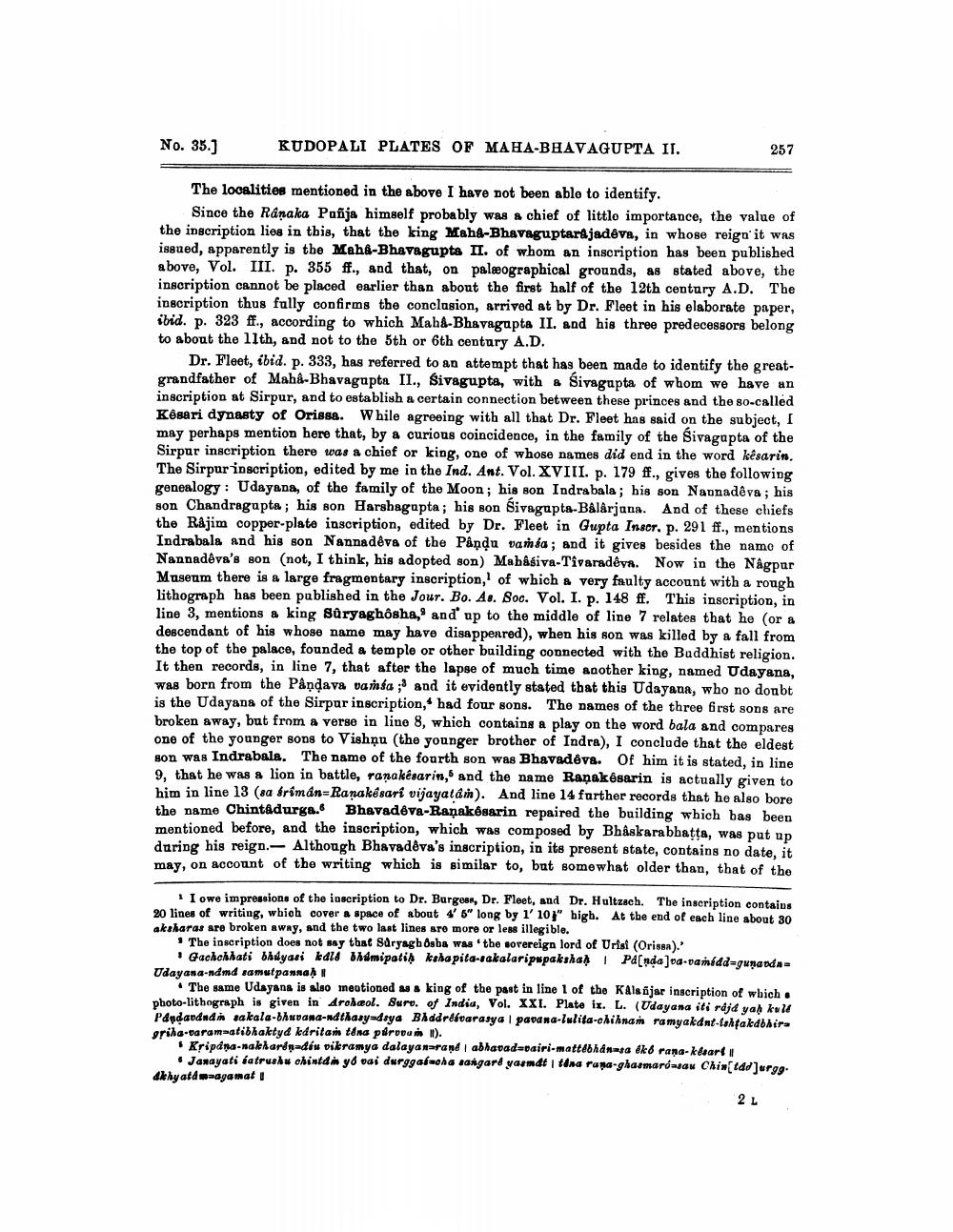________________
No. 35.]
KUDOPALI PLATES OF MAHA-BHAVAGUPTA II.
257
The localities mentioned in the above I have not been able to identify.
Since the Ránaka Pañja himself probably was a chief of littlo importance, the value of the inscription lies in this, that the king Maha-Bhavaguptarijadêve, in whose reign' it was issued, apparently is the Mahl-Bhavagupta II. of whom an inscription has been published above, Vol. III. p. 355 ff., and that, on palæographical grounds, as stated above, the inscription cannot be placed earlier than about the first half of the 12th century A.D. The inscription thus fully confirms the conclusion, arrived at by Dr. Fleet in his elaborate paper, ibid. p. 323 ff., according to which Maha-Bhavagupta II. and his three predecessors belong to about the 11th, and not to the 5th or 6th century A.D.
Dr. Fleet, ibid. p. 333, has referred to an attempt that has been made to identify the greatgrandfather of Mahd-Bhavagupta II., Sivagupta, with a Sivagapta of whom we have an inscription at Sirpur, and to establish a certain connection between these princes and the so-called Kesari dynasty of Orissa. While agreeing with all that Dr. Fleet has said on the subject, I may perhaps mention here that, by a curious coincidence, in the family of the Sivagapta of the Sirpur inscription there was a chief or king, one of whose names did end in the word kêsarin. The Sirpur inscription, edited by me in the Ind. Ant. Vol. XVIII. p. 179 ff., gives the following genealogy : Udayana, of the family of the Moon; his son Indra bala; his son Nannadeva; his son Chandragupta; his son Harshagapta; his son Sivagapta-Balárjana. And of these chiefs the Räjim copper-plate inscription, edited by Dr. Fleet in Gupta Inscr. p. 291 ff., mentions Indrabala and his son Nannadeva of the Påņdu vamba; and it gives besides the namo of Nannadeva's son (not, I think, his adopted son) Mabasiva-Tivaradêya. Now in the Nagpur Museum there is a large fragmentary inscription, of which & very faulty account with a rough lithograph has been published in the Jour. Bo. As. Soc. Vol. I. p. 148 ff. This inscription, in line 3, mentions a king Suryaghosha, and up to the middle of line 7 relates that he (or a descendant of his whose name may have disappeared), when his son was killed by a fall from the top of the palace, founded a temple or other building connected with the Buddhist religion. It then records, in line 7, that after the lapse of much time another king, named Udayana, was born from the Påndava vanta ;' and it evidently stated that this Udayana, who no donbt is the Udayana of the Sirpar inscription, had four sons. The names of the three first sons are broken away, but from a verse in line 8, which contains a play on the word bala and compares one of the younger sons to Vishņu (the younger brother of Indra), I conclude that the eldest son was Indrabala. The name of the fourth son was Bhavadêva. Of him it is stated, in line 9, that he was a lion in battle, ranakénarin, and the name Ranak@sarin is actually given to him in line 13 (sa briman=Ranakesari vijayatdı). And line 14 further records that he also bore the name Chintadurga. Bhavadova-Ranak@sarin repaired the building which has been mentioned before, and the inscription, which was composed by Bhaskarabhatta, was put up during his reign. Although Bhavadêva's inscription, in its present state, contains no date, it may, on account of the writing which is similar to, but somewhat older than that of the
I owe impressions of the inscription to Dr. Burgess, Dr. Fleet, and Dr. Hultzach. The inscription contains 20 lines of writing, wbioh cover a space of about 4' 5" long by 1' 10" high. At the end of each line about 30 akakaras are broken away, and the two last lines are more or less illegible.
The inscription does not say that Saryagh Osba was the sorereign lord of Urisi (Orisan)."
Gachchhati bhiyari kals bdmipatin ksha pita-vakalaripupaksha | Panda Joa-namiddagunandaUdayana-ndmd samutpannah
The same Udayana is also meotioned making of the past in line 1 of the Kals jar inscription of wbich. photo-lithograph is given in Archeol. Suro. of India, Vol. XXI. Plate iz. L. (Udayana iti raja yah kuld Pandandndin sakala-bhuvana-nd thasyadaya Blddrévarasya I pavana-lulita-chihnan ramyakdnt-lahtakdbdir. grilla.caramelibhaktyd kdrita tena piropa ).
. Kripana-naklardnadíu vikramya dalayararandabhavad-pairi-mattebhanasa dk6 rana-kdar
• Janayati iatruku chindi yo pai durggarwoha sangard yarndt tona raga-ghasmardajaw Chinidd Jurgg. Ik hy atdwaagamat
2 L




